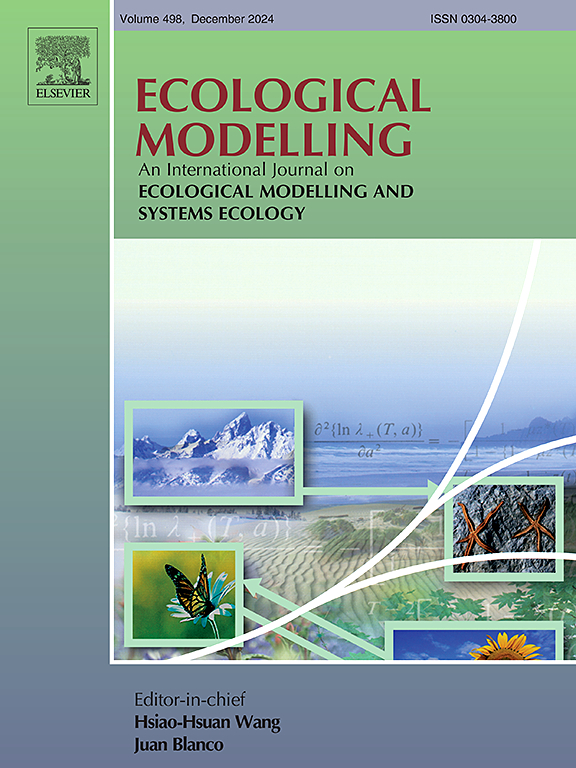Dynamic energy budget (DEB) parameter estimation for the globally invasive Quagga Mussel (Dreissena rostriformis bugensis)
IF 2.6
3区 环境科学与生态学
Q2 ECOLOGY
引用次数: 0
Abstract
Impacts of Dreissena spp. on infrastructure, nutrient cycling, and productivity in invaded ecosystems have been well-documented. These effects are influenced by mussel density, growth, and reproduction; therefore, there is a need to parameterize a dreissenid bioenergetic model that can be incorporated into lake management decision support tools. Since Quagga Mussels (D. rostriformis bugensis) are the most common dreissenid species in the Laurentian Great Lakes, we compiled existing data from the past 20 years of literature to estimate Dynamic Energy Budget (DEB) model parameters for Quagga Mussels to predict mussel growth, filtration, temperature dependence, and nutrient fluxes. Our estimations for shape coefficient, maximum reserve density, Arrhenius temperature, surface area-specific ingestion rate, and surface area-specific searching rate were within the range of previously published DEB parameters for bivalves, with key differences that we relate to Quagga Mussel success in the Great Lakes through growth model simulations. Additionally, since dreissenids feed differentially on available prey, selectivity coefficients for common taxonomic algal groups and sizes were estimated which can be used to calculate effective food concentrations and estimate the environmentally available food density for Quagga Mussels. Finally, we developed an initial calibration of a DEB model in order to predict Quagga Mussel clearance rates in response to varying environmental conditions. Since field-collected data are not designed for precise parameter estimation, significant uncertainties in parameter estimates currently persist, highlighting the need for well-controlled laboratory experiments. The components of this model hold potential for integration into biogeochemical models to elucidate mussel effects on nutrient cycling and their response to future environmental changes. This integration enhances our understanding of ecosystem dynamics and can inform effective management strategies for invasive species in aquatic environments.
全球入侵斑驴贻贝动态能量收支(DEB)参数估算
对入侵生态系统的基础设施、养分循环和生产力的影响已经得到了充分的研究。这些效应受贻贝密度、生长和繁殖的影响;因此,有必要参数化湖泊管理决策支持工具中可纳入的德雷森德生物能模型。由于斑驴贻贝(D. rostriformis bugensis)是Laurentian五大湖中最常见的dreissenid物种,我们从过去20年的文献中收集现有数据,估算斑驴贻贝的动态能量预算(Dynamic Energy Budget, DEB)模型参数,以预测贻贝的生长、过滤、温度依赖和营养通量。我们对形状系数、最大储备密度、阿伦尼乌斯温度、表面积特定摄食率和表面积特定搜索率的估计在先前公布的双壳类DEB参数范围内,我们通过生长模型模拟将其与五大湖斑贝贻贝的成功联系起来。此外,由于斑驴贻贝对可用猎物的摄食存在差异,本文还估算了常见藻类类群和大小的选择系数,该系数可用于计算斑驴贻贝的有效食物浓度和环境可利用食物密度。最后,我们开发了一个DEB模型的初始校准,以预测斑驴贻贝对不同环境条件的清除率。由于现场收集的数据不是为精确的参数估计而设计的,因此参数估计目前仍然存在很大的不确定性,这突出表明需要进行控制良好的实验室实验。该模型的组成部分具有整合到生物地球化学模型的潜力,以阐明贻贝对营养循环的影响及其对未来环境变化的响应。这种整合增强了我们对生态系统动力学的理解,并可以为水生环境中入侵物种的有效管理策略提供信息。
本文章由计算机程序翻译,如有差异,请以英文原文为准。
求助全文
约1分钟内获得全文
求助全文
来源期刊

Ecological Modelling
环境科学-生态学
CiteScore
5.60
自引率
6.50%
发文量
259
审稿时长
69 days
期刊介绍:
The journal is concerned with the use of mathematical models and systems analysis for the description of ecological processes and for the sustainable management of resources. Human activity and well-being are dependent on and integrated with the functioning of ecosystems and the services they provide. We aim to understand these basic ecosystem functions using mathematical and conceptual modelling, systems analysis, thermodynamics, computer simulations, and ecological theory. This leads to a preference for process-based models embedded in theory with explicit causative agents as opposed to strictly statistical or correlative descriptions. These modelling methods can be applied to a wide spectrum of issues ranging from basic ecology to human ecology to socio-ecological systems. The journal welcomes research articles, short communications, review articles, letters to the editor, book reviews, and other communications. The journal also supports the activities of the [International Society of Ecological Modelling (ISEM)](http://www.isemna.org/).
 求助内容:
求助内容: 应助结果提醒方式:
应助结果提醒方式:


